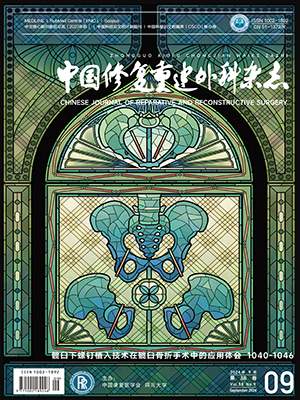Objective To investigate an effect of the Fixion expandable intramedullary nail on treatment of the closed fracture of the tibial shaft, and to compare the Fixion nail with the traditional locked intramendullary nail.Methods From September 1, 2005 to August 31, 2006, 79 patients (53 men, 26 women; aged 17-57 years, 37 years on average) with the closed fracture of the tibial shaft were treated with the Fixion expandable intramedullary nail, and the effect of the nail was evaluated. According to the AO classification, the patients were typed as Type 42A or Type 42B. And the patients were divided into the following two groups: the expandable intramedullary nail group (n=31) and the traditional locked intramedullary nail group (n=48). Of the 31 patents in the first group, 24 were of Type 42A and 7 were of Type 42B; of the 48 patients in the second group, 37 were of Type 42A and 11 were of Type 42B. All the patients were followed up after operation. Observation was made on the time of the bony callus development and the time of the clinical healing of the bone,and on whether there was the bone malunion, late healing, disunion or infection. The limb function was also evaluated.Results The follow-up of all the 79 patients for 4-15 months averaged 10.3 months revealed that in the expandable intramedullary nail group, the average operating time was 35 minutes (range, 20-60 minutes), with no requirement of blood transfusion. The X-ray examination showed that the bony callus developed as early as 4 weeks after operation. The clinical healing time of the bone was 3-8 months, averaged 5 months. All the patients in this group had the healing by first intention. Evaluatedby the Johner-Wruhs method, an excellent result was found in 28 patients, goodin 3 patients, and poor in none of the patients, with an excellent/good rate of100%. In the traditional locked intramedullary nail group, the average operating time was 75 minutes (range, 45-110 minutes), with no requirement of blood transfusion. The X-ray examination showed that the bony callus developed as early as 4.5 weeks after operation. The clinical healing time was 3-12 months, averaged 5.8 months. In this group, 46 patients had the healing by first intention and 2 patients had the healing by second intention. Evaluated by the JohnerWruhs method,an excellent result was found in 35 patients, good in 11 patients, and fair in 2 patients, with an excellent/good rate of 95.8%.Conclusion The expandable intramedullary nail treatment has advantages of less invasion, simpler manipulation, earlier weightbearing of the bone, quicker healing ofthe bone fracture, and fewer complications. This kind of treatment is worth popularizing in the medical practice if the indication is strictly controlled.
Citation: JIN Dongxu,ZHANG Zhichang,SUN Yuqiang,et al.. COMPARISON STUDY BETWEEN FIXION EXPANDABLE INTRAMEDULLARY NAIL AND TRADITIONAL LOCKEDINTRAMEDULLARY NAIL IN TREATING CLOSED FRACTURE OF TIBIAL SHAFT. Chinese Journal of Reparative and Reconstructive Surgery, 2007, 21(6): 629-632. doi: Copy




